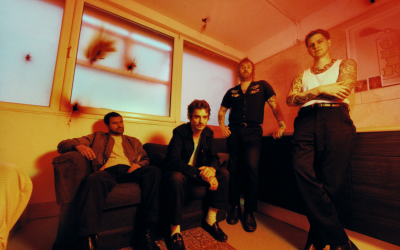Words: George Pizani
A dramatically-hued Carpathian landscape is set alight by the convergence of sacrifice, ego and empathy in Dmytro Sukholytkyy-Sobchuk’s quietly gut-punching feature debut.
Produced in a Ukraine on the verge of Russian invasion, it’s hardly surprising that Sukholytkyy-Sobchuk’s articulation of bucolic regional identity is one that is underscored by the constant threat of simmering violence. In this small, yet deeply packed film, feared crime bosses wear the same folk-inspired carnival masks as innocent villagers and fairytale-esque forests hide vast smuggling networks.

Pamfir follows Leonid (played by Oleksandr Yatsentyuk), who after a period of time spent abroad, returns to his hometown on the Ukraine-Romania border and attempts to leave behind his career of smuggling in favour of a legitimate revenue stream. Set against the backdrop of the traditional Malanka festival, in which villagers create homemade masks and travel from door to door exchanging food and drink, Leonid is reunited with his wife and teenage son, and attempts to create a more honest livelihood for himself.
However, after a fire engulfs the village church and the finger is pointed at Nazar (Leonid’s teenage son), the recently reformed smuggler is forced, through a mess of financial obligations and political corruption, to return to his life of uneasy criminality. Pamfir is an incredibly specific film; Sukholytkyy-Sobchuk used a regional Ukranian dialect that only native speakers will understand and incorporated the visually memorable Malanka festival as a central component of the film’s plot.

From the initial stages of the film’s production, “The [Malanka] celebration was fundamental to the story” Sukholytkyy-Sobchuk explains. The ancient festival not only only serves as a fascinating addition to Pamfir’s overall visual style, but also offered the filmmaker an opportunity to explore the creation of self-identity in a far more flexible way than would typically be possible: “In this celebration you have the moment that the people create the mask and change their personality. They work with the ego and the alter-ego.” Sukholytkyy-Sobchuk said.
Part of the specificity that makes viewing Pamfir such a consuming experience undoubtedly comes from Dmytro Sukholytkyy-Sobchuk’s own aversion to derivative cinema: “I don’t like references” the director states. This is not a glib statement from Sukholytkyy-Sobchuk, who is notably proficient in striking a tone and sense of genre that is well-beyond easy categorisation. Pamfir has so far been described as a crime-thriller, a comedy and even by some as folk-horror – tentative definitions that do little to articulate the thematic and tonal nuances of this Cannes Film Festival 2022 feature.
Throughout our conversation, Sukholytkyy-Sobchuk makes an effort to stress the role of collaboration in the production of Pamfir, singling out Mykyta Kuzmenko (Director of Photography) as central to the film’s painterly composition of long tracking shots and meticulously arranged static images. Whilst remaining conscious to avoid overt influence, Sukholytkyy-Sobchuk did study the work of Carravagio for Pamfir’s distinctive visual language, explaining “ We discussed a lot about paintings, I said to [Kuzmenko], ‘just view anything you can of Carravagio’, and he bought a massive album of Carravagio paintings. Every night we would just be going through this book.”

Speaking to the philosophy behind Pamfir’s unique style, Sukholytkyy-Sobchuk explained that both he and Mykyta Kuzmenko “decided that the longshots would be where we link with the character. The idea was if he runs; we run, if he walks slowly; we walk slowly, if he stays; we stay.” The effect of this photographic mirroring is one of constant movement, playing a vital part in establishing a cinematic gaze that is unflinchingly empathetic to Leonid’s personal strife.
Thanks to Sukholytkyy-Sobchuk narrative ingenuity and multi-layered approach to articulating sensory experiences, Pamfir is an unexpected example of how geographic and cultural specificities can be woven into stories to create art that is universally poignant, and is a forceful debut feature from one of Ukraine’s most promising young directors.











